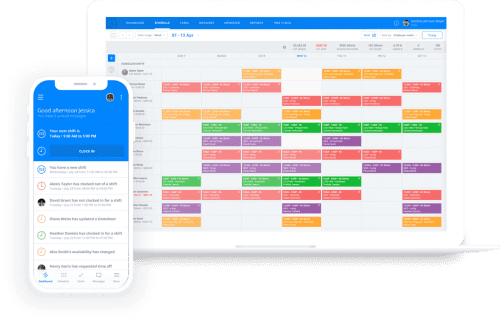Staffing and Scheduling: Differences Managers Need to Know
Knowing the difference between staffing and scheduling helps managers make good ...

Assembling the right job shifts for your business and your employees can be a complicated and time-consuming task. But when you know what options are available, you can customize your schedule to better satisfy everyone’s needs.
In this article, we discuss some of the common types of job shifts to help you create the best work plan for your team.

Job shifts (or “work shifts”) are blocks of time that divide the day into more manageable parts so your business has employees at work for all the hours that it’s open.
The vast majority of shifts run for eight hours a day. Some, however, are shorter or longer in order to provide maximum coverage for the business.
Depending on when your business is open, your team may work:
And, while many businesses rely on the five-day workweek, you may choose to structure the schedule so that your employees work all the hours of a full-time shift or a part-time shift in three or four days.
Again, it really depends on what your business needs to operate efficiently and be successful.

The most common job shifts are first, second, and third.
The first shift — a.k.a. the day shift — is the more “traditional” workday that typically runs from 7:00, 8:00, or 9:00 a.m. to 3:00, 4:00, or 5:00 p.m. (although, even those hours may vary).
The second shift — a.k.a. the swing shift — generally runs from the afternoon to around midnight.
For example, if your first shift runs from 7:00 a.m. to 3:00 p.m., your second shift could run from 3:00 p.m. to 11:00 p.m.
The third shift — a.k.a. the night shift, the graveyard shift, or any number of alternative names — typically runs from the end of the second shift to the beginning of the first shift.
For example, if your second shift runs from 3:00 p.m. to 11:00 p.m., your third shift could run from 11:00 p.m. to 7:00 a.m. (at which time, your first shift would start again).
That said, all of these job shifts are flexible to the point that you can customize them to fit your company’s needs.
Your business may need 60 minutes of downtime between operational hours so that the first shift runs from 7:00 a.m. to 2:00 p.m., second shift runs from 3:00 p.m. to 10:00 p.m., and third shift runs from 11:00 p.m. to 6:00 a.m.

Flex job shifts are built around a set amount of core hours when all employees work at the same time. After the core hours are fulfilled, it’s entirely up to the employee when they accumulate the rest of their work hours.
For example, you may set your core hours at 11:00 a.m. to 2:00 p.m. with the stipulation that your employees may start their shift no earlier than 5:00 a.m. and finish their shift no later than 9:00 p.m.
With those rules in mind, a team member could choose to work 6:00 a.m. to 3:00 p.m. with a one-hour break at 10:00 a.m. for lunch.
Flex work shifts offer a number of potential benefits, including:
That said, flex work shifts also come with a number of potential drawbacks, including:
You’ll have to weigh these pros and cons in order to decide if implementing flex work shifts is right for your team and your business.
Talk to your team members to get their input before making any changes to their schedule.
Incorporating split shifts for your employees means they will work a few hours at one point during the day, have several hours off, and then work the rest of their hours during another part of the day.
For example, one team member might work from 8:00 a.m. to 10:00 a.m., be off for five hours, and then finish working from 3:00 p.m. to 5:00 p.m.
In a rotating job shift schedule, team members work first shift one week (or one day), second shift the next week (or the next day), and third shift the following week (or following day).
For example, if your business is open five days a week, the schedule might look something like this for one employee:
Assigning an employee to work one of the on-call shifts means they would be available to work any time, day or night, as the employer demands — or, in some cases, not at all if there’s no need.
Most employers use on-call shifts to plan for emergencies or as a backup in case a no call, no show situation occurs.
The key variable is that the employee is available whether they actually come into the business or not.

Compressed work shifts typically provide the same number of hours as the regular “9-to-5” shifts, but do so in fewer days (e.g., four 10-hour days Monday through Thursday instead of five eight-hour days Monday through Friday).
This type of schedule can provide a better work-life balance for employees while still giving management the ability to plan and predict labor costs.
In this unique shift schedule, team members work four nine-hour days (36 hours) followed by one eight-hour day. For payroll purposes, you apply the first half of the eight-hour workday to the first week and the second half to the following week.
All told, that adds up to 40 hours worked Monday through Friday of the first week, and 40 hours worked Monday through Thursday of the second week with that Friday completely off.
We realize that may be hard to visualize, so here’s a basic example of a 9/80 schedule in action.
Monday: 8-12 and 1-6 with an unpaid lunch break in-between (9 hours total)
Tuesday: Same
Wednesday: Same
Thursday: Same (for a total of 36 hours)
Friday: 8-12 (first week ends) + 1-5 (second week starts)
Saturday: Off
Sunday: Off
Monday: 8-12 and 1-6 with an unpaid lunch break in between (9 hours total)
Tuesday: Same
Wednesday: Same
Thursday: Same (for a total of 40 hours including the four hours worked the previous Friday)
Friday: Off
Saturday: Off
Sunday: Off
Keep in mind that this is just one example of a 9/80 work schedule. Another option might be to have employees start at 7 a.m. and work until 5 p.m. That would still allow for the requisite nine hours in one day.
Unpredictable shifts change from week to week (or even day to day) without following a regular pattern.
This type of schedule can be difficult for employees because they have no idea when they’ll work next. It can be difficult for employers because they have to recreate the schedule from scratch pretty much every time.
Fixed shifts basically mean that an employee will work set days and hours, but they won’t necessarily work the standard “9-to-5” workweek.
For example, one employee might work Wednesday through Sunday from 10:00 a.m. to 6:00 p.m., while another employee works Tuesday through Saturday from 8:00 a.m. to 4:00 p.m.

A full-time classification means that a team member may work up to 40 hours per week — although the Fair Labor Standards Act (FLSA) does not define that number.
Instead, they leave the definition (and the hours) up to the employer. As long as an employee doesn’t accumulate more than 40 hours per week in any amount of shifts, the business can dictate for itself what it considers full-time.
For example, team members could work five 8-hour shifts, four 10-hour shifts, or six 6.5-hour shifts throughout the week. The shifts worked don’t matter, just the total amount of hours.
A part-time classification means that a team member will work fewer than 40 hours per week in any combination of days and hours (though, again, the Department of Labor does not set a number for this type of work).
For example, you may adopt part-time work shifts that have an employee on the clock for three six-hour days, two five-hour days, or even one four-hour day each week.
It all depends on what your business needs and what your employee will agree to.
Seasonal work shifts are those that come and go according to the time of year and, in large part, according to the holidays on the calendar.
The Christmas season is probably the best example of a time when businesses use these types of shifts. The increase in shoppers during the holiday season sometimes results in businesses needing to stay open longer and add more employees to help keep up with the heavy traffic.
Seasonal need doesn’t mean that you have to add more work shifts to the schedule — although longer work hours may necessitate that as well. Instead, you can add seasonal hires to the existing set of shifts so that you have more employees available to get things done.
Overtime laws can have a big influence on the number of work shifts you run during the time your business is open and which employees work those shifts.
At the most basic, overtime laws state that an employee may work up to 40 hours in any seven-day period. If an employee accumulates more than 40 hours in a week, the employer must pay them at least 1.5 times the employee’s regular hourly wage.
So, if an employee makes $13 per hour, their overtime rate would be $19.50. That would mean that if they worked 45 hours in a seven-day period, you would pay them $13 per hour for the first 40 hours, and $19.50 per hour for the next five hours.
It’s easy to see that overtime hours can have a dramatic effect on not only your work shifts, but also your labor budget and your bottom line.
To ensure that you’re abiding by overtime laws in all your scheduling, consult a qualified accountant or a lawyer with knowledge of your industry.

Your business’s hours of operation may be the most influential factor you’ll consider when choosing which type of work shifts to use in your schedule.
For example, if your business is open from 8 a.m. to 6 p.m., you may only need one shift per day.
That said, you may find that a specialized first, second, and third shift schedule fits the needs of your business better and looks something like this:
An overlapping, part-time schedule like this may help your business maintain the number of employees it needs to cover the busy hours during midday while preventing team members from having nothing to do because there are too many people on the clock at one time.
This is just one basic example of how you can use your hours of operation in conjunction with the different types of work shifts to create a schedule that benefits everyone involved.
Another major variable that affects the types of work shifts you use is the days your business is open.
For example, if your business is open Monday through Saturday, you may need to add another type of shift on Saturday to accommodate these extended hours and to prevent employees who work Monday through Friday from straying into overtime.
This, and the hours of operation mentioned in the previous section, highlight the possibility that you may need to be creative with your scheduling in order to make everything work.
Don’t be afraid to experiment to find the schedule that works for everyone on your team.
The number of employees on your team may also affect the work shifts that you can use in your business.
For example, if you only have enough employees to cover your hours of operation and your days worked, you may not need an on-call shift. Similarly, if you have just the right number of employees, it may not be practical to implement a flex work shift into the mix.
As we mentioned earlier, you’re certainly welcome to experiment with the different types of work shifts to see if one or the other benefits your team, but keep things as streamlined as possible. The simplest solution may be the best option for you, your business, and your team.

If you run a restaurant, cafe, coffee shop, food truck, catering business, or other type of food-service establishment, managing different shifts can be a challenge. Implementing even the simplest work shifts can become difficult and time-consuming if you don’t use the right tools.
Software designed for the restaurant industry can help.
Sure, you could settle for tools that were never designed for scheduling work shifts. Or you could implement a solution that offers restaurant-specific features designed to benefit your business and your team in ways you may not have thought of.
Look for a work shift scheduler that includes:
Features like these can help you organize and manage your job shifts faster and with less confusion and mistakes.
They can also help streamline everything you and your team do on a daily basis so that work flows better and without the regular speed bumps that can often slow it down.

If some of these job shifts seem a bit complicated to manage, don’t let that deter you from giving them a try. They may be just what your team and your business need.
Scheduling software, like Sling, can help simplify even the most complicated combination of job shifts so that you can sit down, make your schedule, and move on to more pressing matters.
All of Sling’s cloud-based features — from schedule creation to time clock to payroll calculations to task management and communication — help make it easy for you to build the best schedule possible, distribute it with ease, apply changes, and juggle time-off requests.
Sling even provides suggestions and warnings when you’ve double-booked a team member or created a conflict in another part of your schedule.
For more free resources to help you manage your business better, organize and schedule your team, and track and calculate labor costs, visit GetSling.com today.
See Here For Last Updated Dates: Link
This content is for informational purposes and is not intended as legal, tax, HR, or any other professional advice. Please contact an attorney or other professional for specific advice.
Schedule faster, communicate better, get things done.